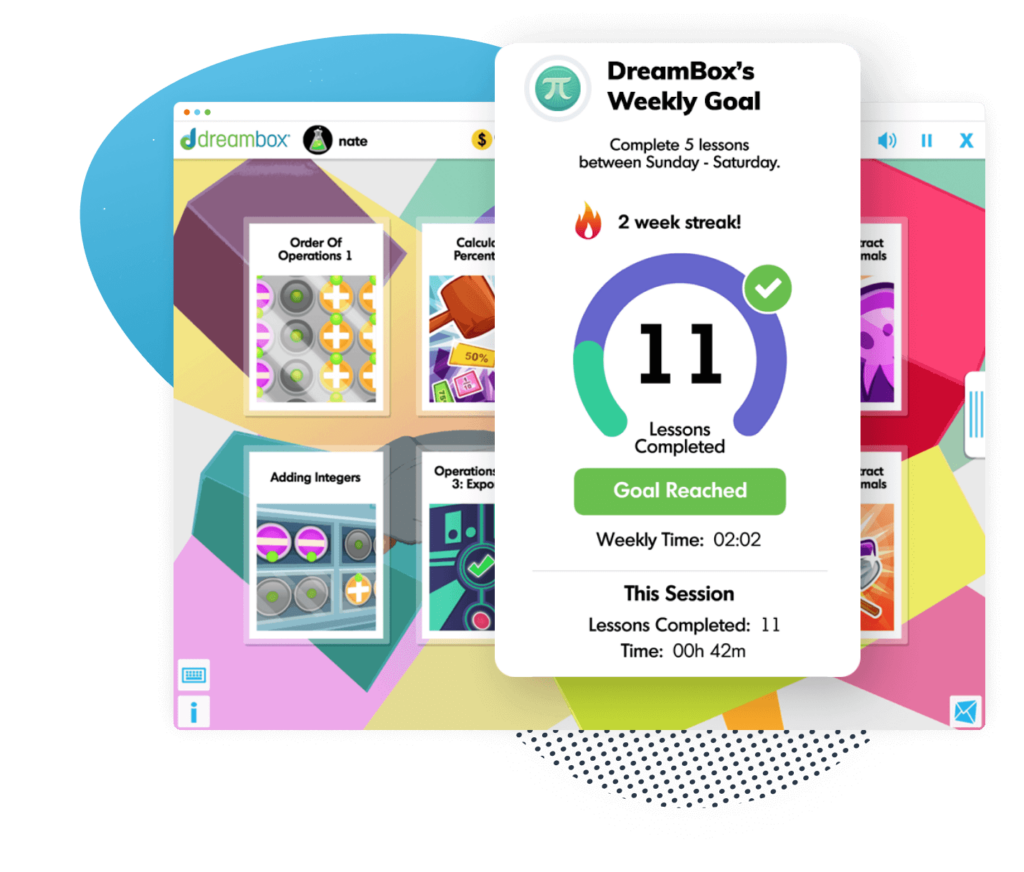What to Know for Third-Grade Homeschool Curriculums
Discover what third grade homeschoolers need to know and learn more about choosing a 3rd-grade homeschool curriculum.

Author
Lisa Luciano
Published:
March 2025
Key takeaways
- • Find out which subjects to teach third-grade homeschoolers
- • Discover the skills that third graders need to learn
- • Discover ways to supplement your curriculum with real-life and hands-on activities
Get ready for third grade: a wonderful year of transition, enthusiasm, and accomplishment. Although third graders are at various levels of reading and math progress, during the third-grade homeschooling year, many parents start to sense a shift. Third graders are moving toward increased independence and ability in school subjects. They still need instruction and guidance, but they are often eager and able to do more independently. During this year, you can help them tackle longer chapter books, more detailed projects and writing assignments.
As we dive into third-grade subjects and skills, remember the unique benefit of homeschooling: you can take as much time as your child needs to master a skill before moving on. Allow them to grasp concepts fully until they learn them.
Which subjects are taught in the third grade?
The core subjects taught in 3rd-grade homeschool are: math, language arts (reading, grammar, and writing), history, science, social studies, and physical education. Let’s break these down into the individual skills students typically master by the end of third grade.
Math
- Add, subtract, multiply, and divide whole numbers
- Add and subtract numbers with regrouping
- Know multiplication facts 0-10
- Tell time to the minute
- Interpret data from simple tables and graphs
- Recognize fractions and divide shapes into fractions
- Make change from a dollar
- Draw two-dimensional and three-dimensional shapes
- Figure the area and perimeter of rectangles
- Use basic units of measurement
Reading
- Know third-grade vocabulary and high-frequency words
- Read multi-syllable words
- Apply phonetic strategies to unfamiliar words
- Identify the main idea of a reading passage
- Distinguish between fact and opinion
Grammar and Writing
- Use correct punctuation and capitalization
- Identify parts of speech
- Use the writing process (organizing, first draft, editing, revising, final copy)
- Write a well-constructed paragraph with the main idea
- Write a short story with a beginning, middle, and end
History
- Know a basic overview of U.S. history
- Learn U.S. geography: mountain ranges, rivers, and the Great Lakes.
- Describe features of U.S. regions
- Demonstrate knowledge of basic mapping terms
- Use maps to identify locations
Science
One key component of a 3rd-grade homeschool science curriculum is teaching students how to work and think like scientists using problem-solving skills and the scientific method. A 3rd-grade homeschool curriculum may offer a sampling of several fields of science. In addition to life science, earth science, and physical science, a 3rd-grade homeschool curriculum may include engineering and technology. A third-grade homeschooled student can create models and build simple machines. Here are some concepts grasped by the end of third grade:
1. Life Science
- Explore the traits and life cycles of living organisms
- Learn about the habitats of living things
- Discover the needs of plants and animals
- Learn about ecosystems, food chains, and webs
2. Earth and Space
- Learn about Earth’s structure
- Explore Earth’s natural resources
- Learn about the solar system
- Learn the relationships between the Earth, the moon, and the sun
3. Physical Science
- Learn about states of matter (liquid, solid, gas)
- Explore forces, energy, and motion
- Learn about simple machines, magnetism, and gravity
Social Studies
- Learn the role of rules and laws in daily life
- Understand the three branches of government
- Know about national landmarks and founding documents
- Understand the relationship between natural resources and products
- Know about the economic, cultural, and scientific contributions of leaders
- Understand the role of families, groups, and communities
Physical Education
By third grade, gross motor skills are almost fully developed. Both gross and fine motor skills will continue to be refined over the next few years. In a 3rd grade curriculum for physical education, students apply movement to basic skills. They work on body management by engaging in sports and games. This is a key time to form personal habits and create a foundation for lifelong health and well-being. A third-grade homeschool curriculum for physical education may explore four basic areas of physical fitness: endurance, strength, flexibility, and balance. By the end of third grade, many students can:
- Walk on a balance beam
- Combine a string of movements easily (jump up to catch a ball, then run with it)
- Do several sit-ups
- Do several push-ups
- Kick a ball with accuracy at a target within 10-15 feet
- Dribble a basketball
- Do handstands and cartwheels
- Jump rope
Table of contents
Get help with homeschool math with DreamBox!
How to choose a third-grade homeschool curriculum
Choosing a homeschool curriculum might seem overwhelming if you are new to homeschooling. Here are some questions to consider as you search for a 3rd-grade curriculum that suits your child’s unique needs and abilities:
- Is the material taught clearly?
- Does the curriculum style keep students interested and engaged?
- Are there repeated opportunities for students to reinforce skills?
- Does the curriculum reflect your worldview?
- Is the curriculum appropriate for your child’s age and ability level?
- Are the learning objectives easy to understand?
- Is the curriculum cost within your budget?
- Are there additional resources and support available?
- Does it make tracking progress easy?
What are the best third-grade homeschool curriculums?
Attend any homeschool conference and view the huge array of curriculum choices. Some have been around for a long time, and others feature the latest in online learning. Some include a stack of workbooks, and others offer project-based learning. Consider what type of curriculum will work best for your family. If you are working with one child, you may have the time to be directly involved more than a parent with 5 children in various grades. With that in mind, here are some quality options to consider.
Language Arts 3rd-grade homeschool curriculum
Here are some of the favorite choices for the 3rd-grade homeschool curriculum — each representing different ways of teaching language arts.
- Rabbit Trails: Teach different ages together
Rabbit Trails language arts uses a Charlotte Mason approach, combining high-quality books with the lessons. The book becomes the core for all related lessons, activities, and crafts. You can teach all the kids together, which saves time.
- Night Zookeeper: Easy, fun, online
Night Zookeeper is fully online, which makes it as easy for parents as it is fun for kids. Students are improving their writing skills with fun activities; they might not even realize they are learning.
- Evan-Moor: Engaging workbooks, many levels
Evan-Moor offers homeschool resources in a variety of subjects up to Grade 8. This language arts curriculum targets a variety of skills and offers both print and e-book versions. To combat summer learning loss, Evan-Moor offers an award-winning bundle of screen-free activities to keep skills sharp and get students ready for the next year.
Math 3rd-grade homeschool curriculum
Finding the right homeschool math program can be so important. There are many choices available, so don’t be discouraged if the first one you choose doesn’t click with your student. Here are some of the top choices for 3rd-grade homeschool math; check this out for more help choosing a math curriculum.
- Saxon Math is a tried-and-true option for many families. There is plenty of repetition so kids can practice the skills they have learned before moving on to new skills. We used these books through algebra. With a big family, it got to be too much for me to correct and record everyone’s progress, so we switched to Teaching Textbooks.
- Teaching Textbooks is a digital math curriculum that offers instruction through animated teaching videos. Then, students do the math problems and receive instant feedback. There is a parent login, enabling parents to see exactly how their child did on the lesson and which ones were marked wrong. This curriculum is ideal for independent learning.
- Math-U-See is a great option for students who struggle with foundational math concepts. It uses a hands-on approach to help kids conquer math.
- Life of Fred is one of the most unique math curriculums out there. It’s all you need for motivated self-learners. It’s like an engaging story with math principles interwoven. No boring drills included, Life of Fred takes kids from the elementary grades through high school. My friend used it for her only child, who adored the program.
History and Social Studies 3rd-grade homeschool curriculum
Social studies for third graders includes a mix of history, geography, government, and economics. Remember to make use of the opportunities that lurk in your local community and state. I was always glad to teach American history in an election year. We watch debates and election updates, learn about the Electoral College, and stay up late coloring states on the U.S. map. Try taking your students on a tour of your state capitol, or visit a living history site. We attended a local county commissioner’s meeting, which helped us learn how county government works. Here are some 3rd grade history homeschool curriculum favorites:
- History Quest uses a project-based approach to history education, covering world history from ancient times to the present.
- Blossom and Root uses an effective interdisciplinary approach, weaving subjects like art, writing, and geography into the study of history.
- Beautiful Feet is a literature-based history curriculum that uses living books to teach history in a memorable way.
- Curiosity Chronicles teaches world history by using living books, timelines, maps, and hands-on projects.
- Story of the World by Susan Wise Bauer takes students on a trip through history, told through fascinating stories. The audio version narrated by Jim Weiss is great for road trips.
- American History Timelines Curriculum by Sunflower Education offers an American history timelines curriculum that makes history hands-on, engaging, and fun.
Science 3rd-grade homeschool curriculum
Science is the ideal place to delight your kinesthetic learners with hands-on activities. We all know that science can be messy, but those kitchen experiments and outdoor science projects will be remembered by your child for a lifetime. Some of the top homeschool science curriculums include: Generation Genius, Moving Beyond the Page, Mel Science Kits, and Real Science Odyssey by Pandia Press. Whatever 3rd-grade science homeschool curriculum you choose, here are ten bonus ways to incorporate science into your homeschool:
- Visit a science museum.
- Visit an aquarium or zoo.
- Take a class at a nature center.
- Raise a monarch butterfly.
- Watch and learn to recognize different types of birds.
- Tend a garden from seed to vegetable.
- Take a local stargazing class.
- Look at a grain of salt, a strand of hair, or a drop of pond water under a microscope.
- Buy a science kit and build something with your child.
- Read science books together, such as The Way Things Work.
Physical education 3rd-grade homeschool curriculum
Homeschoolers have many options for physical education, and they don’t have to mimic what traditional schools do for P.E. Focus on what works for your family, and what you enjoy. Our annual summer swimming lessons always “counted” for P.E. Check out: Home School Family Fitness: The Complete Physical Education Curriculum for Grades K-12 by Dr. Bruce Whitney. There are also many free P.E. curriculum options and lesson plan ideas you may find useful.

The math program that drives results
Get started today!
DreamBox adapts to your child’s level and learning needs, ensuring they are appropriately challenged and get confidence-building wins.
Conclusion
As you prepare for third grade, know that your child is approaching a year of fun learning and stronger skills. As your child progresses, watch for the shift toward increasing independence and give it room to grow. When choosing a curriculum, remember that the materials others rave about may not work for you. Choose the 3rd-grade homeschool curriculum that will work best for your family.
FAQs about 3rd Grade Homeschool Curriculums
Look for a curriculum that engages, teaches concepts clearly, and accommodates your child’s learning style. Find one that is easy to use and within your budget.
Typically, third graders are involved in homeschooling for about 30 minutes per subject and about 3 hours a day. This is not a hard and fast rule. Some lessons will take more time and some less. Work within your child’s needs and your family schedule.
Third-grade homeschoolers enjoy individual or group sports, music lessons, or clubs. Third graders can also be excellent community or church volunteers. Look for opportunities posted at your church, local library, or through your homeschool group.

About the Author
Lisa Luciano
Lisa Luciano earned a B.A. in Elementary Education from Wheaton College. After graduation, she worked at an Asian refugee camp for a year, then taught in the St. Paul Public Schools. She has been a homeschooling mom for the past 28 years. In 2021, Lisa launched a freelance writing business (Eleven Star Content, LLC). In her free time, she enjoys sewing for her Etsy shop and listening to audiobooks while walking. Lisa and her husband José have eleven children and live in rural Minnesota.
Take at home math practice to the next level
Empowering parents and educators to make math practice more impactful. Plus, your kids will love it.


